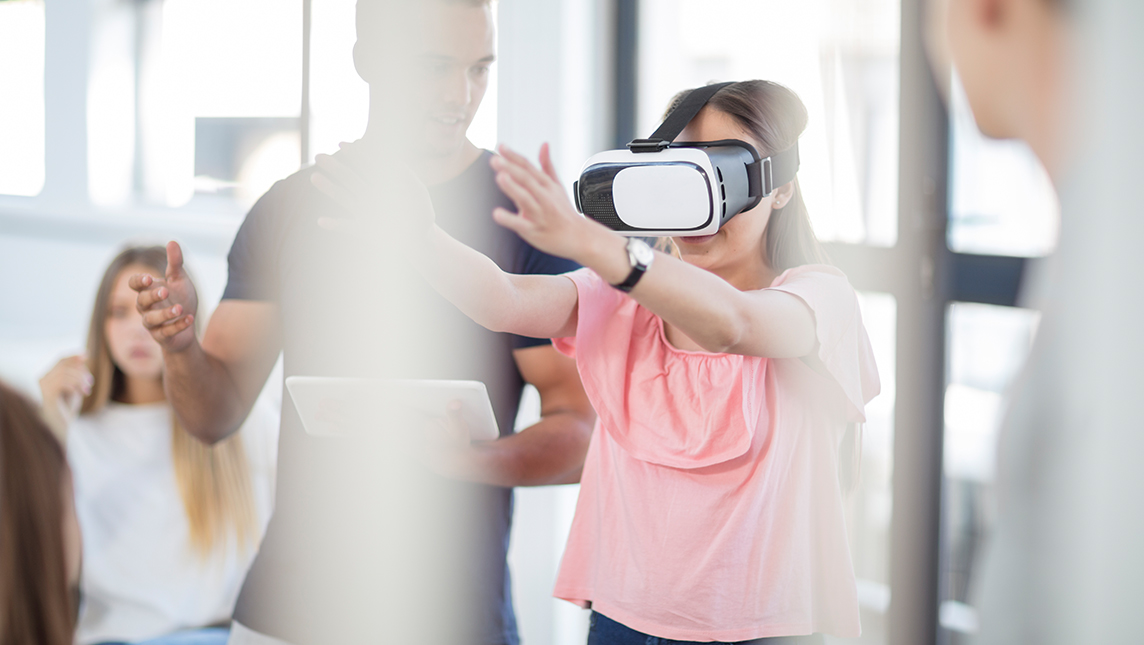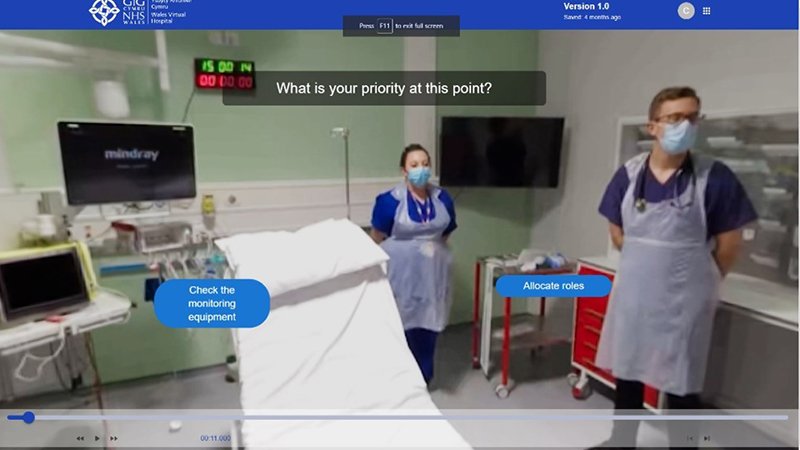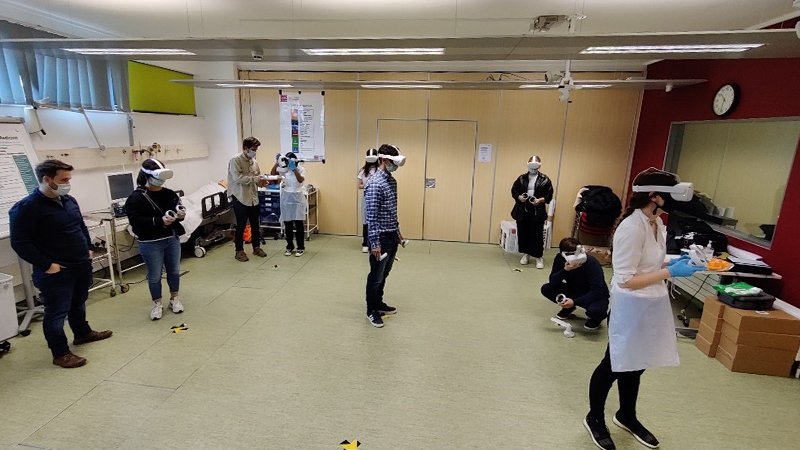
Cardiff University’s multi-disciplinary approach to teaching in clinical disciplines with immersive technology
Cardiff University has been on a journey to develop a virtual hospital for Wales. The immersive online platform was developed in partnership with several Welsh universities, NHS Wales health boards, and Virtustech – a VR company founded by Cardiff University alumni.
Students in the schools of medicine and healthcare sciences were involved in testing and shaping the platform. It empowers staff to create their own immersive, interactive scenarios using a straightforward interface, ensuring that the scenarios are aligned with their curriculum, face-to-face simulations, and programme learning outcomes.
Initially borne out of necessity during the pandemic, the virtual hospital was designed to give students a chance to practice their skills if they were unable to attend simulation labs or face-to-face placements. Seeing the potential of the platform to complement traditional simulation activities, development continued once teaching resumed and Welsh universities are currently integrating it into a range of courses such as medicine, nursing, physiotherapy, midwifery and occupational therapy. So far it has been used by over 500 students.
The platform, which is freely available to all higher education (HE) institutions and health boards in Wales, allows educators to easily create their own immersive learning experiences using 360 degree images and videos, add interactions, deploy them to their students, and share them with colleagues. It has been described as “being like PowerPoint for VR”.
Creating a safe environment to learn
Owen Crawford, digital learning manager says:
“Wales virtual hospital is about providing a safe environment to learn, practice, and be assessed. It’s about bringing E-Learning into an immersive space and bringing patients to life with multimedia, rather than a page of text, and it’s about doing it easily in a way that make it possible for everyone.”
The platform can be used in three main ways:
Shift scenario: similar to a 360 tour, this is an image-based scenario where students can move between locations to visit several patients. During the scenario students can interact with virtual hotspots which contain information, multimedia content, or activities such as reflection, history taking or quiz questions.
Patient journey: a scenario where students are focused on one patient’s specific journey. This could be from location to location, such as from the care home to the ambulance, A&E, the ward then the outpatient clinic, or through the different steps involved at a single location such as taking vital signs, working out a NEWS score and then creating a plan. Like the shift scenario students interact with a variety of hotspots and activities as they progress through the steps.
Video scenario: a scenario where students are immersed into a 360 video, which pauses at relevant points to check their knowledge and understanding. These scenarios can be used on computers, tablets, or via a virtual reality headset, for more time-pressured, or intense scenarios.

The platform enables lecturers to design scenarios aligned to their specific learning outcomes. This allows students to experience various clinical situations that may have not been possible to observe during their clinical placements. Kathryn Price, lecturer Children’s Nursing says:
“Due to the very nature and unpredictability of learning opportunities in the practice setting, student nurses may not be exposed to certain practice situations.”
One of the key benefits of Wales Virtual Hospital is its genuine scalability. Multiple 360 videos/images can be uploaded to the platform, and once you have the equipment you need for filming, and running the VR sessions (VR headsets are optional), you can just get on with creating scenarios. There isn’t a need to purchase additional equipment or content.
Designed with the user in mind
Students were at the heart of the design of Wales virtual hospital. Many actively contributed to its development, by helping to create the scenarios and providing feedback and suggestions. They particularly appreciated how authentic and realistic the scenarios were, as they were filmed in familiar locations such as the university’s simulation labs or their local halls of residence.
They also felt their confidence soar as they were able to demonstrate their knowledge and skills in a variety of different roles within the scenarios. The platform therefore not only serves as an effective learning tool, it also provides students with a sense of empowerment of their clinical capabilities.

For the staff, the platform has been useful in offering opportunities to examine rare cases with their students, so they are prepared when they enter the workplace. Together, they could explore complex life-threatening situations, which they may otherwise encounter once or twice in their lifetime.
Dr Huw Williams, programme director of the ‘Emergency, Pre-hospital and Immediate Care’ Intercalated BSc (EPIC iBSc) says:
“It allows us to rehearse complex, life-threatening and ‘once-in-a-career’ rare scenarios. It also has the added benefit of being logistically easier to distribute standardised learning for national programmes throughout Wales across healthcare specialties and disciplines.”
A technical learning curve
One of the early challenges the team faced was in getting access to affordable camera equipment and then having to manually stitch together the outputs, rather than having an all-in-one built system. With a lack of support from the tech suppliers, there was a fair amount of experimentation involved, in learning how to film, edit post-production and embed graphics.
Andrew Hilbourne, senior multimedia technology officer, says:
“Most of the challenges have been around the tech and the learning curve around using it all because it's new. Learning how to use it was not a straightforward process. The technology was initially moving on quicker than we were.”
The speed with which the technology evolves was also a major concern. Both Owen and Andrew recommend waiting until the very last possible moment to purchase equipment such as headsets, to avoid the pitfalls of investing in out of date kit.
Looking to the future
The next steps for the team are to focus on widescale adoption of the platform by Cardiff University. They’d like the Wales virtual hospital to be as ubiquitous as any other online tool. They have plans to build more scenarios and focus on other use cases such as deploying scenarios within immersive rooms.
In the future, there is potential for the platform to branch out into other curriculum areas, such as architecture, earth sciences and history, and the team are keen to explore student-generated content, such as Architecture students using the platform to develop immersive portfolios.
As the technology evolves, Owen and Andrew are keen to explore how they can incorporate the use of artificial intelligence, 3D models and haptics. Imagine a 3D hospital instantly rendered by an AI prompt. NVIDIA for example, are already showcasing AI tools which can render 3D environments from a few photographs.
Find out more
- Join the UK XR community, where you can network with universities and colleges across the UK